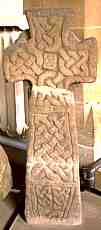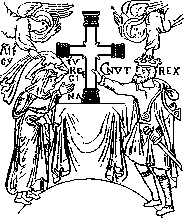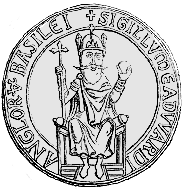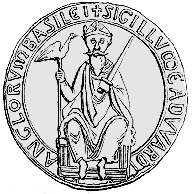





If you are looking at this page without frames, there is more information about medieval writing to be found by going to the home page (framed) or the site map (no frames).
| Anglo-Saxon Charters and Writs | ||||
| By starting with the earliest evidence for written administration in post-Roman Britain, we plunge immediately into some confusion in terminology. The terms charter and writ theoretically have a somewhat different meaning, a charter being a grant or privilege bestowed by authority, while a writ is a command or instruction issued by authority. However, there is such as thing as a written command, sent out to those in authority in a local region, to respect a grant or privilege bestowed by central authority. In the later middle ages, the evolution of administrative functions caused the development of two different kinds of documents, but in their earliest form, documents from the king could have certain characteristics of a charter or a writ. | ||||
| For further clarification, see Bishop and Chaplais 1957 also Backhouse, Turner and Webster (ed) and also visit the website Anglo-Saxon Charters. | ||||
| There are also conventions about how the terms are used. The word charter is sometimes used in a very loose sense to mean any kind of legal document, including business agreements, wills or just about anything else. The term diploma can be used to specify a royal grant or privilege, that is to say, a royal charter. However, there are some differences in form between diplomas as used on the continent of Europe and those which developed in Anglo-Saxon England. One particularly English form of the two types of royal document known in the period is sometimes called a writ, even when it is a charter or diploma. I hope that is all perfectly clear, but if it isn't, it may become so as we proceed. |
 |
|||
| The terminology of Anglo-Saxon charters has nearly as many convolutions as this carved Anglo-Saxon cross in the church of Brompton-in-Allertonshire, Yorkshire. | ||||
| There is a significant corpus of these documents, certainly enough to infer that the literate mode of issuing instructions and granting royal favours was well established in England before the Norman Conquest. However, only a small fraction of the documents exists in authentic, original, single sheet form. The rest are known from later copies in cartularies or have been copied by later antiquarians from lost originals. Many, even of the single sheets, have been proven to be forgeries. In the absence of any chancery records from this period, a detailed interpretation of how the system worked in practice may be a little tricky. But history is not for the fainthearted. | ||||
 |
||||
| The earliest charters were in Latin and started appearing around the 7th century under the names of the regional leaders who styled themselves kings of small domains such as Mercia or Kent. Later, under the kings of a united England, the documents proliferated. However, there is no real evidence for a royal chancery until around the time of Edward the Confessor in the mid 11th century. The earlier charters were probably penned in monastic scriptoria, sometimes even in the monasteries which were the beneficiaries of the lands or privileges being granted. | ||||
| King Cnut donates a cross to a monastery. | ||||
| The Anglo-Saxon Charters website illustrates Latin charters of King Aethelwulf dated 843, King Edgar dated 961 and King Aethelred dated 1001, among others. | ||||
| These Latin royal charters, or diplomas, were detailed documents of imposing style. They were recorded on a single sheet of parchment. They began with a cross and a long and florid introduction. They included a date entered in a verbose format, or sometimes several as the year might be given numerically as well as in relation to the regnal year of the monarch. In the case of a land grant, details of the grant and the boundaries of the land were entered in the vernacular with great accuracy. This was followed by a curse against violators of the grant. The names of the grantor and all the witnesses were then entered, each beside a sign of the cross. | ||||
| Although the form of these documents supposedly initially derived from that of private deeds of the Roman era, there was a certain difference in concept. The Anglo-Saxon documents were produced, not by a society which valued the legal significance of the written word as such, but which placed its faith in witnessed oral testimony. These charters bore none of the validating insignia of the Roman documents from which they derived; no autograph signatures, no notarial insignia, no seal. Nevertheless, they became regarded as legal title deeds to land, even after the witnesses required to validate them were dead and gone. | ||||
 |
||||
| The first two lines of a charter of King Coenwulf of Mercia from 812 AD. (From Wright 1879) | ||||
| The above sample is from a long document recording a grant of land to Wulfred, archbishop. You can see the sign of the cross at the beginning and then an invocation to the deity In nomine dei summi regis aeterni. This is followed by the date in Roman numerals and then sweeps along into the year of the gloriosissimi reign of the king. The sanctions clause indicates that anyone acting against these provisions will be subject to Christ's justice, the ultimate real estate tribunal. The names of the grantor, the grantee and six witnesses are entered against crosses. | ||||
 |
During the reign of Alfred the Great, in the late 9th century, there was something of a move towards vernacular literacy. Great works were translated from Latin into Old English and this may have owed something to Englishness as an ethnic concept in the face of invading Danes. In the 10th century, reforms to Benedictine monasticism in England tended to restore Latin as the language of liturgy and the church. After the reign of the Danish king Cnut (or Canute as he was styled in textbooks of my youth), the ruling aristocracy was engulfed in episodes that involved rebellious sons, incontinent mothers and murderous brothers drawn from the Danish, Anglo-Saxon and Norman camps. The reign of Edward the Confessor saw another assertion of Englishness through the use of vernacular language, this time in the form of legal documents. | |||
| The shrine of Edward the Confessor in Westminster Abbey. Despite his Norman affiliations, he apparently became the patron saint of Englishness. | ||||
| A significant number of royal charters recording grants of land or rights to a beneficiary, which could be an institution or an individual, were produced in the vernacular in the reign of Edward the Confessor. These are sometimes referred to as vernacular writs. The format, or diplomatic, of these documents is highly standardised and rather different to that of the Latin charters. It was a new format and formed the basis for later English royal charters. Even the physical appearance of the documents was retained after the Norman Conquest. | ||||
| It is uncertain whether Edward the Confessor had a royal chancery as such. The names of some royal clerks are known, apparently recruited from the royal chaplains, but whether they actually wrote documents or acted as the brains behind the formula is really not known. It is most likely that monastic scribes were still doing the actual writing work. The church was probably the sole agent of literacy in the land, and a close relationship between church and chancery existed right through the middle ages. The earliest surviving examples of the great seal also date to this reign. This double sided wax seal was not used to seal up the document, but to authenticate it. The writ consisted of a single sheet of parchment with two strips partially cut across the bottom. The seal was attached to one while the other was used to tie up the folded document. The seal dangled down from the closed document, so you knew exactly who it was from and that you had better open it. It was probably read aloud at a meeting of the shire court. |
 |
|||
 |
||||
| The two sides of the great seal of Edward the Confessor. Unfortunately, these drawings are probably taken from a forged seal, but it looked more or less like that. | ||||
| |
||||
|
If you are looking at this page without frames, there is more information about medieval writing to be found by going to the home page (framed) or the site map (no frames). |
||||